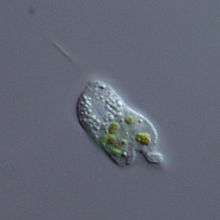Cercomonadida
Cercomonads are small flagellates,[1] widespread in aqueous habitats and common in soils.[2]
| Cercomonads | |
|---|---|
 | |
| Cercomonas sp | |
| Scientific classification | |
| Domain: | |
| (unranked): | |
| (unranked): | |
| Phylum: | |
| Class: | |
| Order: | Cercomonadida Poche, 1913 emend. Karpov et al. 2006 |
| Genera | |
| |
Characteristics
The cells are generally around 10 μm in length, without any shell or covering. They produce filose pseudopods to capture bacteria, but do not use them for locomotion, which usually takes place by gliding along surfaces.
Most members have two flagella,[3] one directed forward and one trailing under the cell, inserted at right angles near its anterior. The nucleus is connected to the flagellar bases and accompanied by a characteristic paranuclear body.
Classification
Genetic studies place the cercomonads among the Cercozoa,[4] a diverse group of amoeboid and flagellate protozoans. They are divided into two families.
- The Heteromitidae tend to be relatively rigid, and produce only temporary pseudopods.
- The Cercomonadidae are more plastic, and when food supplies are plentiful may become amoeboid and even multinucleate.
The classification of genera and species continues to undergo revision. Some genera have been merged, like Cercomonas and Cercobodo. Others like Helkesimastix, Sainouron and Cholamonas have been moved to Helkesida,[5] while the rest of the family Heteromitidae has been moved to Glissomonadida.[6]
- Order Cercomonadida Poche 1913 sensu Bass et al. 2009
- Genus Paracercobodo Hovasse & Combescot 1959
- Family ?Krakenidae Dumack, Mylnikov & Bonkowski 2017
- Genus Kraken Dumack et al. 2016
- Family Paracercomonadidae Cavalier-Smith & Karpov 2012
- Genus Brevimastigomonas Brabender et al. 2012
- Genus Metabolomonas Brabender et al. 2012
- Genus Nucleocercomonas Brabender et al. 2012
- Genus Paracercomonas Cavalier-Smith & Bass 2006
- Family Cercomonadidae Kent 1880 sensu Karpov et al. 2006 [Cercobodonidae Hollande 1942]
- Genus Eocercomonas Karpov et al. 2006
- Genus Filomonas Cavalier-Smith & Karpov 2012
- Genus Cavernomonas Vickerman 2009
- Genus Cercomonas Dujardin 1841 emend. Karpov et al. 2006 non emend. Ekelund et al. 2004 [Neocercomonas Ekelund, Fredslund & Daugbjerg 2004; Cercobodo Krassilstschick 1886; Cercomastix Lemmermann 1913; Dimastigamoeba Blochmann 1894; ?Mukdeniamonas Skwortzov 1960; ?Changia Skwortzov 1960 non Sun 1924; ?Reptomonas Kent 1880; Dimorpha Klebs 1892 non Gruber 1882]
- Genus Neocercomonas Ekelund, Daugbjerg & Fredslund 2004
References
- Mylnikov, A.P.; Karpov, S.A. (2004). "Review of diversity and taxonomy of cercomonads" (PDF). Protistology. 3 (4): 201–217.
- Karpov SA, Bass D, Mylnikov AP, Cavalier-Smith T (June 2006). "Molecular phylogeny of Cercomonadidae and kinetid patterns of Cercomonas and Eocercomonas gen. nov. (Cercomonadida, Cercozoa)". Protist. 157 (2): 125–58. doi:10.1016/j.protis.2006.01.001. PMID 16647880.
- Bass, D.; Howe, A.; Mylnikov, A.; Vickerman, K.; Chao, E.; Edwards Smallbone, J.; Snell, J.; Cabral Jr, J.; Cavalier-Smith, T. (2009). "Phylogeny and Classification of Cercomonadida (Protozoa, Cercozoa): Cercomonas, Eocercomonas, Paracercomonas, and Cavernomonas gen. Nov". Protist. 160 (4): 483–521. doi:10.1016/j.protis.2009.01.004. PMID 19589724.
- Bass D, Richards TA, Matthai L, Marsh V, Cavalier-Smith T (2007). "DNA evidence for global dispersal and probable endemicity of protozoa". BMC Evol. Biol. 7: 162. doi:10.1186/1471-2148-7-162. PMC 2194784. PMID 17854485.
- Cavalier-Smith, T. (2018). "Kingdom Chromista and its eight phyla: a new synthesis emphasising periplastid protein targeting, cytoskeletal and periplastid evolution, and ancient divergences". Protoplasma. 255 (1): 297–357. doi:10.1007/s00709-017-1147-3. PMC 5756292. PMID 28875267.
- Howe, A. T.; Bass, D.; Vickerman, K.; Chao, E. E.; Cavalier-Smith, T. (2009). "Phylogeny, taxonomy, and astounding genetic diversity of Glissomonadida ord. nov., the dominant gliding zooflagellates in soil (Protozoa: Cercozoa)". Protist. 160 (2): 159–189. doi:10.1016/j.protis.2008.11.007. PMID 19324594.